Dinosaurs are the stuff of science fiction movies and the imagination of every little kid (and kid at heart).
Non-avian dinosaurs aren’t around anymore — they completely died out roughly 66 million years ago, which paved the way for other species to proliferate and dominate Earth — so fossils are all that scientists can work with to get an idea of what they looked like and how they behaved. And while science has indeed gotten dinosaurs wrong more than a few times, there are also numerous examples of dinosaurs that, despite appearing to be way too bizarre to be anything more than mistaken reconstructions, were likely as strange as their fossilized traces made them out to be.
According to Britannica, the number of recognized dinosaur genera (generic names like Triceratops) sits at over 800, covering at least a thousand species (with specific names like Triceratops horridus and Triceratops prorsus). Considering those numbers, it’s no surprise that somewhere down the line, a bunch of absolute prehistoric weirdos would pop up on the dinosaur evolutionary tree. From a mighty meat-eater with almost-nonexistent forelimbs to a duck-dinosaur “hybrid” that paleontologists nearly dismissed as a fake, here are some of the weirdest dinosaurs to ever walk the planet.
A HERBIVOROUS DINOSAUR WITH RIDICULOUSLY HUGE CLAWS
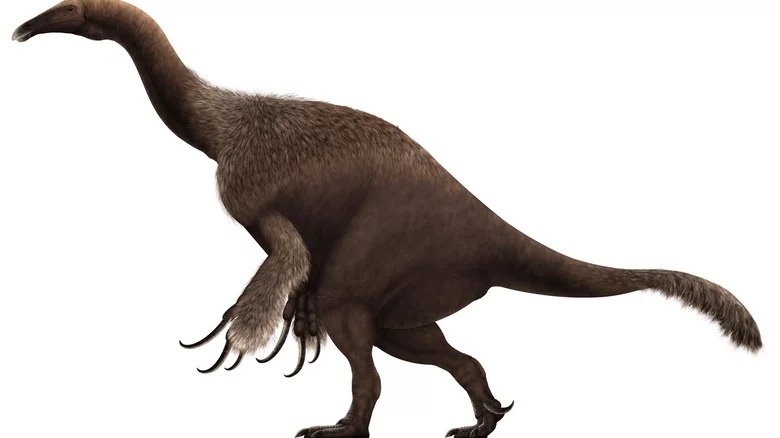
A cursory glance at the enormous claws of Therizinosaurus would probably make anyone unfamiliar with the dinosaur think that it’s a fearsome predator. However, paleontologists would be quick to disagree, as their analysis of its fossilized remains actually suggests that it used its claws — which may have measured over 3 feet long in life — for gathering food from tall vegetation and defending itself from meat-eaters (per National Geographic).
The fact that there are few legally obtained Therizinosaurus remains for experts to examine has prompted them to theorize about the dinosaur’s existence based on what they determined to be its related species. Still, according to paleobiology researcher Mark Witton, it’s likely that Therizinosaurus had the longest claws of any animal that ever lived. That said, this dinosaur is no stranger to paleontological extrapolation. After all, this creature’s own name was based on a deep misunderstanding of exactly what it was supposed to be when it roamed what is now the Gobi Desert in Mongolia over 70 million years ago.
When Russian paleontologist Evgeny Maleev had to describe this peculiar dinosaur in a 1954 paper, he only had partial remains of the animal’s huge claw bones to work with. He assumed that the bones belonged to a “giant, turtle-like reptile,” prompting him to give it the name Therizinosaurus cheloniformis. Its genus name came from the Greek word for reaping or mowing (“therizo”), while its species name translates to “turtle-like” (via the Canadian Museum of Nature).
AN ‘ENORMOUS RIVER-MONSTER’ WITH A GIGANTIC SAIL ON ITS BACK
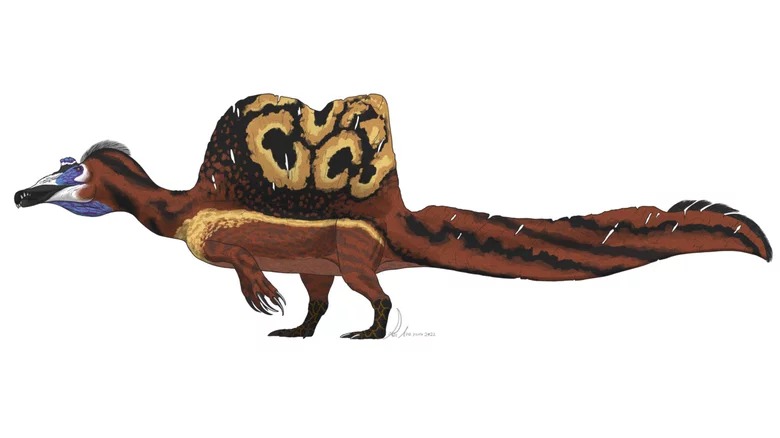
Considering how Spinosaurus aegyptiacus almost became completely lost to time because of World War II, it’s impressive that science knows as much about the dinosaur as it does now. Based on the limited (albeit growing) information that paleontologists have about Spinosaurus aegyptiacus, it was likely one of the most dangerous dinosaurs to ever exist – and quite frankly, one of the most bizarre as well.
As National Geographic recounts, the 1944 bombing of Munich’s Paleontological Museum obliterated the only known remains of the enigmatic dinosaur at the time, which were discovered during expeditions in Egypt led by Bavarian paleontologist Ernst Stromer nearly three decades earlier. Tragically, this left the paleontological world with Stromer’s illustrations and notes as the only remaining traces of Spinosaurus, and for about 50 or so years, the sail-backed predator remained a mystery. This changed near the turn of the century when new specimens were discovered and described, providing scientists with additional information about the meat-eater.
Clocking in at an estimated length of 49 feet, the sail-backed Spinosaurus dwarfed even the ever-popular Tyrannosaurus rex. There’s also ample evidence that it was semi-aquatic — the first dinosaur of its kind known to live in such a manner — and that its powerful tail and toothy snout made it an efficient river hunter (via Sci-News). In fact, per BBC, researchers at the University of Portsmouth called the creature an “enormous river-monster.” Its ginormous sail remains a mystery, though, with guesses about its function ranging from attracting mates to regulating body temperature to corralling prey.
A CONTROVERSIAL DINOSAUR WITH SPEAR-LIKE SHOULDER FEATHERS
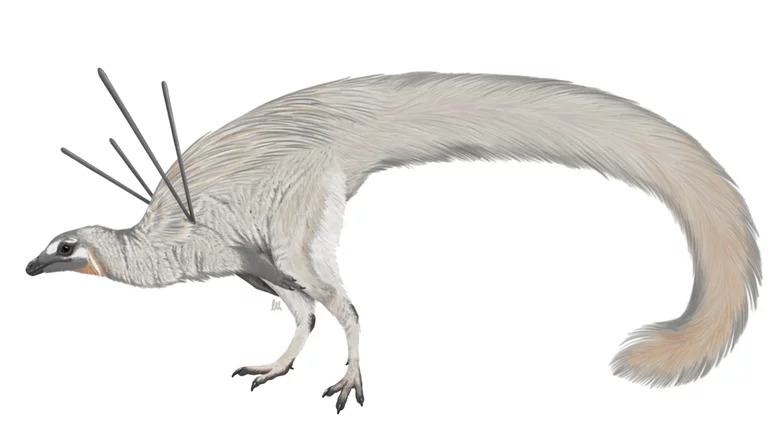
As far as strange dinosaurs go, it’s hard to make a list without thinking of Ubirajara jubatus. After all, reconstructions of the animal based on its fossilized remains make it look like it took a couple of arrows to both of its shoulders. Interestingly, its bizarre shoulder feathers aren’t the only newsworthy thing about this dinosaur, as even the path toward its discovery and description is mired in controversy.
When Ubirajara was publicly unveiled in a 2020 paper published in Cretaceous Research, it received a fair amount of attention. The authors analyzed a 120-million-year-old fossil from a German museum that it had acquired 25 years earlier (per National Geographic). The prehistoric remains, which were discovered in northeastern Brazil’s limestone deposits, revealed a dinosaur estimated to have been 4.5 feet long and over a foot tall in life. What truly sets Ubirajara apart from other dinosaurs of comparable size are its spear-like shoulder feathers, which scientists speculate could have helped increase its odds of finding a suitable mate.
Unfortunately, the scientific community latched on to the discovery for another reason. Obtaining fossils through less-than-legitimate means has been a longstanding issue in the paleontological world, and it seemed like Ubirajara had the same problem. As museum director Alexander Kellner confirmed via Science Magazine, Brazil’s laws do not permit any sort of fossil exportation, which raised doubts that the German museum may have smuggled Ubirajara out of Brazil. The study authors have since withdrawn their paper.
AN ARMORED DINOSAUR WITH A MESOAMERICAN WEAPON FOR A TAIL

The Cretaceous period certainly gave the world some very odd-looking dinosaurs, and Stegouros was no exception. In fact, it gave scientists enough reason to come up with an entirely new dinosaur subgroup for it.
First described in a 2021 paper in Nature, Stegouros lived approximately 74 million years ago in prehistoric Chile. Scientists named it after the Greek words for “roof” (stegos) and “tail” (oura) as a reference to its tail weapon. Its species name (elengassen), on the other hand, came from a mythological creature rooted in the region where the dinosaur was unearthed. While Stegouros may have looked a lot like other armored dinosaurs (ankylosaurs), its unique tail weapon made it stand out: Unlike the typical club-like formations in most ankylosaur tails, Stegouros sported a flat tail weapon with seven pairs of bony projections surrounding it. In an article on Sci-News, the authors noted its resemblance to the macuahuitl, a wooden spiked club strongly associated with Mesoamerican civilizations.
In addition, the researchers noted that Stegouros turned out to be close with two other unique ankylosaur species (Australia’s Kunbarrasaurus ieversi and Antarctica’s Antarctopelta oliveroi). According to the authors, the similarities in the dinosaurs’ tail structures were enough evidence to suggest that they may have evolved from a particular ancestor that took a different turn on the ankylosaur evolutionary tree. This prompted them to propose an entirely new subgroup (clade) of ankylosaurs, Parankylosauria, under which the three species could be classified.
THE ONLY KNOWN DINOSAUR WITH SINGLE-FINGERED HANDS
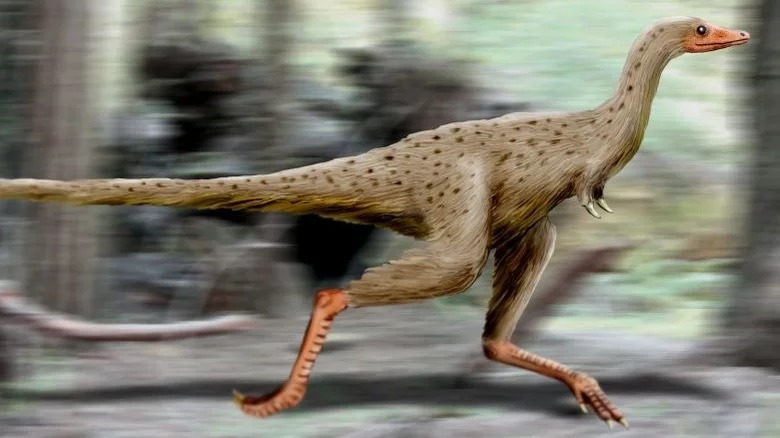
Given how much human beings rely on their ability to properly grasp and hold things with their hands and fingers, it may be hard to picture how other species could survive and even thrive without such a useful trait. Enter Linhenykus, a dinosaur that lived over 70 million years in what is now Mongolia. This small creature’s species name, monodactylus (“single finger”), is a reference to what makes it unique among all the dinosaurs: To date, it is the only non-avian dinosaur known to have just one digit on each of its forelimbs.
According to UCL News, Linhenykus (named after Linhe, a district in Inner Mongolia) likely only grew to be the size and weight of today’s big parrots. While it’s unclear to paleontologists exactly why Linhenykus didn’t have the two tiny (and almost vestigial) outer digits that the other small dinosaurs related to it possessed, it’s possible that the single-fingered meat eater’s strange hands were effective tools for hunting insects, as the dinosaur could have used its pick-like digits to dig into nests.
In their 2011 paper published in the Proceedings of the National Academy of Sciences, the authors suggested that the distinctive hands of Linhenykus may have represented “a complex mosaic pattern of manual evolution” in its dinosaur subgroup. In the case of Linhenykus, the species may have lacked two fingers simply because it didn’t need them.
A MEAT-EATING DINOSAUR WITH A BIZARRE BACK
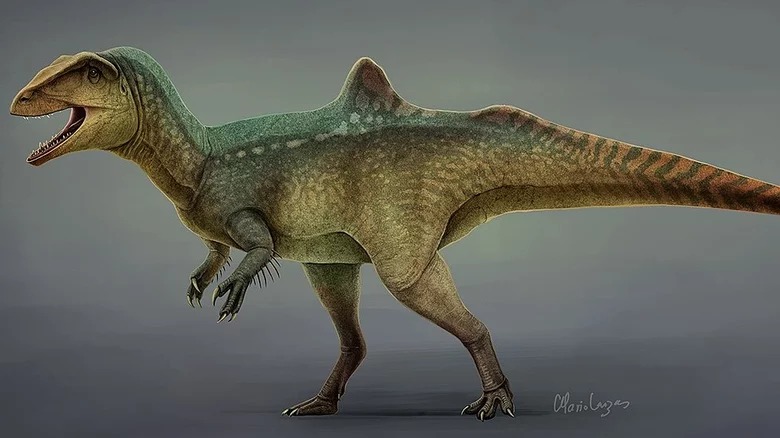
Concavenator corcovatus was far from being the largest, longest, or most dangerous dinosaur among its Cretaceous cohorts. However, when it was found in the Las Hoyas sedimentary deposit in Spain’s La Huérguina Formation, the paleontologists who discovered it took note of two peculiar characteristics that clearly distinguished it from other meat-eating dinosaurs of similar size: the bumps on its forearm, which strongly suggested quill knobs, and its ridiculously tall eleventh and twelfth vertebrae, which made it look like it had two crests jutting out of its back (via Nature).
Regarding Concavenator’s forearm bumps, U.K.-based paleobiologist Michael Benton told Nature that they were quite similar in appearance “to insertions on rather massive flight feathers on bird wings,” which suggested that the creature may have sported quills or at least proto-feathers of some sort. If this were true, it would add another stage in the evolutionary history of feathers. However, many experts did not agree with this interpretation, and subsequent research proposed that these “quill knobs” may have actually been intermuscular lines functioning as tendon attachments.
As for the other characteristic of Concavenator that (literally) stand out, scientists are still in the dark about the real purpose of the carnivore’s mysterious hump. Regardless of whether it could have been a body temperature regulator or simply a way to attract potential mates, Benton perhaps put it best (as published in Nature): “We can’t say anything about it other than: ‘Isn’t it weird?'”
THE ‘HORNY’-EST DINOSAUR EVER FOUND

According to the Natural History Museum of Utah, Kosmoceratops — whose name combines the Greek words for “ornamented” or “ornate” (kosmos) and “horned face” (ceratops) — may have had the most number of horns of any dinosaur ever discovered. Like many of its iconic relatives, Kosmoceratops had a horn right above each eye, as well as one jutting out of the end of its nose. In addition, however, it had a horn on each cheek, 10 spikes decorating the top of its massive, nearly six-foot-long skull, and a bunch of spikes adorning the sides of its frill. This dinosaur existed in the latter part of the Cretaceous period and likely measured an astonishing 15 feet from end to end.
The creature’s specific name (richardsoni) recognizes its discoverer, geological engineer and “accidental paleontologist” Scott Richardson (per the University of Utah). Among all of the ceratopsian dinosaurs discovered within this century, Kosmoceratops stood out because of its “elaborate skull ornamentation,” even though scientists aren’t completely sure about the purpose it served.
As Scott Sampson (the lead author of the study in which Kosmoceratops was described) explained, it wouldn’t have made much sense for the dinosaur to use its head ornaments as offensive or defensive weapons due to the peculiar way they were arranged on its skull and frill. Rather, it’s more likely that the horns and frills of ceratopsians like Kosmoceratops were mainly for display, either to attract mates or scare off rivals.
A MYSTERIOUS DINOSAUR WITH TERRIBLE HANDS
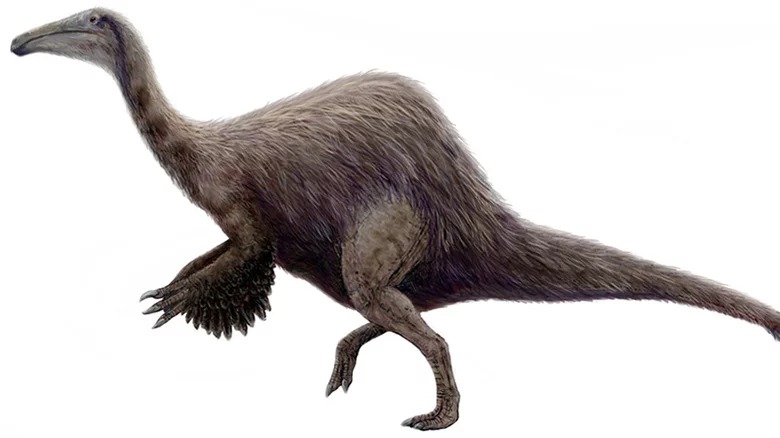
When Polish paleontologist Zofia Kielan-Jaworowska unearthed the first known remains of Deinocheirus in 1965, she wasn’t really sure about what she was looking at. It was a strange sight: a very small assortment of the creature’s bones, which included two humongous, three-clawed forelimbs that measured about 7.9 feet long (via Nature). Five years later, researchers named the strange discovery Deinocheirus mirificus. Its generic name combines the Greek words for “terrible” (deinos) and “hand” (cheir), while its specific name pertains to the weird way its ginormous forelimbs were constructed.
For more than four decades, those were the only documented traces of Deinocheirus, which gave experts a particularly hard time making heads or tails out of the “terrible-handed” dinosaur. This changed when two new specimens were unearthed in 2006 and 2009 (per Nature), giving paleontologists a clearer idea of what Deinocheirus was like when it was alive. According to National Geographic, estimates pegged Deinocheirus to be about 36 feet in length and approximately 6.5 tons in weight. It was the largest among the ostrich-like dinosaurs (ornithomimosaurs), described by paleontologist Stephen Brusatte as “a colossal, slow-moving, horse-headed, hump-backed dinosaur that looks like something out of a bad sci-fi movie.” He also concluded that Deinocheirus likely ate pretty much anything it could grab with its gigantic mitts. In addition, Deinocheirus had “thick, bony spines” along its back and a tail that could have supported feathers.
A DINOSAUR SO PECULIAR, SCIENTISTS THOUGHT IT WAS A FAKE
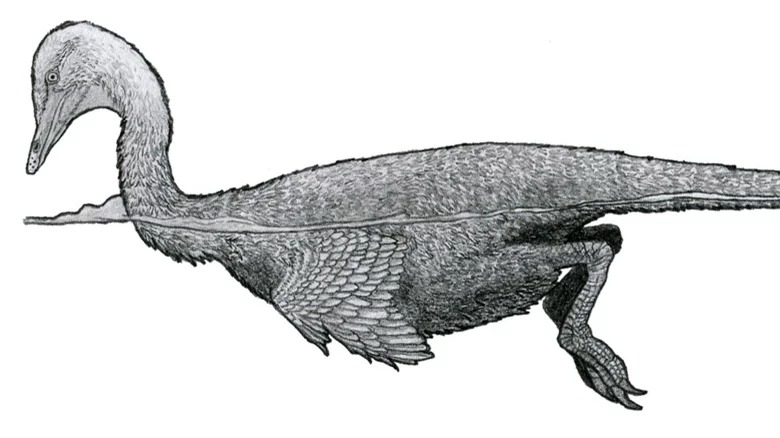
Part raptor, part duck, and part penguin, the curious-looking Halszkaraptor was such an absurd sight that the paleontologists who initially looked at it nearly dismissed it as a fraud.
Discovered in southern Mongolia’s Djadochta Formation — an area that scientists believe was part of a rich, thriving ecosystem during the Late Cretaceous period, per National Geographic – Halszkaraptor’s first known remains were poached and illegally transported out of the country, eventually ending up in the possession of fossil dealer and collector François Escuillié (via Smithsonian Magazine). Curious about the authenticity of the creature, Escuillié sent it to paleontologist Pascal Godefroit. Due to its strange characteristics (paddle-like arms akin to a penguin’s, plus foot claws like a Velociraptor’s), Godefroit’s team initially thought it was too bizarre to be real. Upon closer inspection, however, they found more of the dinosaur’s bones in the orange limestone where it was encased, including a long neck like a swan’s and a snout reminiscent of a duck’s.
Named after Escuillié and Polish paleontologist Halszka Osmólska, Halszkaraptor escuilliei’s morphological characteristics suggest that it could have been amphibious and may have primarily fed on fish.
A TURKEY-SIZED, BUCK-TOOTHED DINOSAUR
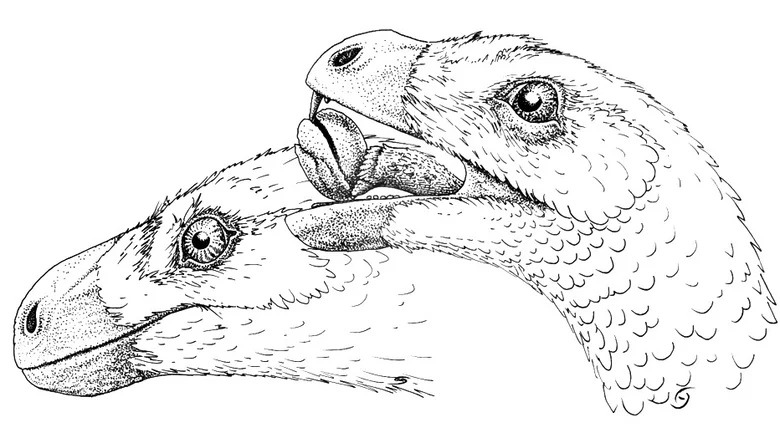
First described in a 2002 paper published in Nature, Incisivosaurus can perhaps be likened to a turkey with a parrot-like head and rabbit’s teeth. Take some time to let that absurd mental image sink in.
Unearthed in China’s Yixian Formation — a remarkably rich and well-preserved fossil bed dating back to the early Cretaceous period — Incisivosaurus gauthieri shared many morphological traits with other theropods (three-toed, hollow-boned dinosaurs, many of which were carnivorous). Incisivosaurus gauthieri’s generic name references its peculiar dentition, while its specific name honors vertebrate paleontologist Jacques Gauthier. Subsequent discoveries of feathered fossils identified as Incisivosaurus lent credence to the idea that it was covered with feathers.
Due to its strange teeth and marks of wear and tear that appeared similar to those found in herbivorous dinosaurs, scientists concluded that Incisivosaurus was likely a plant-eater, or was at least omnivorous. Meanwhile, a 2022 paper published in Scientific Reports puts forward the idea that Incisivosaurus had a remarkably powerful bite, comparable to related species that were over 30 times more massive.
A CARNIVOROUS DINOSAUR WITH DEMONIC BROW HORNS AND COMICALLY TINY ARMS
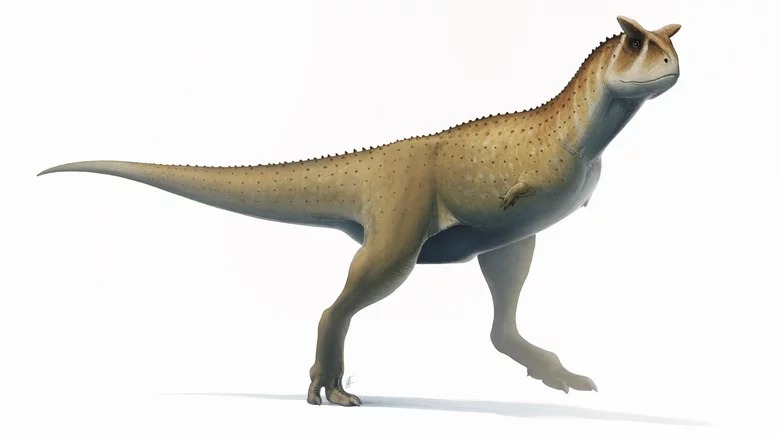
Admittedly, having a name that literally translates to “meat-eating bull” (via National Geographic) does set lofty expectations. And while its distinctly demonic skull — in particular, the two brow horns located right above its eyes — gives Carnotaurus sastrei an impressive profile, its oddly proportioned arms somehow manage to look even more ridiculous than Tyrannosaurus rex’s famously tiny forelimbs.
According to Smithsonian Magazine, some experts believe that the freakishly small hands and lower forelimbs of Carnotaurus may have been completely useless for helping the meat-eating dinosaur catch its victims. The article also cites a study published in Palaeontology in which researchers compared the arms of Carnotaurus to those of other tiny-limbed, bipedal carnivorous dinosaurs (abelisaurids). Interestingly, while the researchers were able to identify certain characteristics in its arms that could distinguish Carnotaurus from its relatives, they weren’t able to figure out why the fearsome predator had such tiny mitts.
That said, despite Carnotaurus’s hilariously small limbs, its Cretaceous-era prey probably still had plenty of reason to be afraid of it. In a study from the University of Alberta cited by National Geographic, experts found that Carnotaurus appears to have been built for short-burst sprinting, particularly because of its strong leg and tail muscles. Coupled with its iconic horns that made it truly look like a dinosaur from hell, it may actually have been a raging carnivorous “bull” in its heyday.
A BIRD-LIKE DINOSAUR WITH RIBBON-LIKE TAIL FEATHERS

The idea that birds sprang forth from dinosaurs has become more popular and widely accepted in recent years, especially with the increasing amount of evidence directly linking the two iconic animal groups on the evolutionary tree. Take Epidexipteryx, for example. First described in a 2008 paper published in Nature, this flightless dinosaur from Inner Mongolia is said to have lived over 150 million years ago. The fact that it sported a “fluffy, down-like covering” along with four “enormously long, ribbon-like shafted tail feathers” has made scientists confident enough to designate it as the oldest known species to have those unusual traits.
Interestingly, Epidexipteryx hui (whose generic name means “display wing”) lacks the contour feathers that can be found on the limbs of today’s birds. In an interview with BBC News, Oxford University’s Animal Flight Group chief Dr. Graham Taylor posited that Epidexipteryx’s decorative feathers serve as proof that the ancestors of today’s birds “used [their ornamental feathers] in show even before they were used in flight.”
Src: grunge.com








